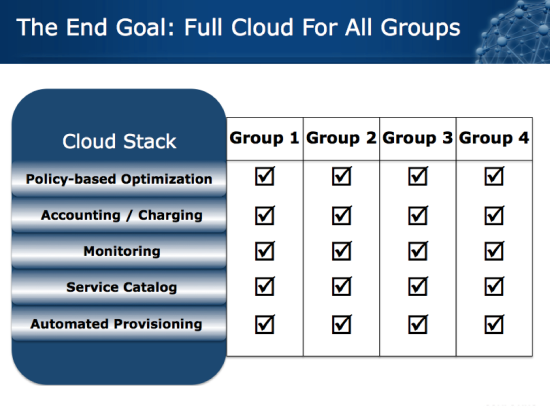In-Depth
Best Practices for Implementing a Private Cloud (Part 1 of 2)
In the first of a two-part series, we examine the importance of usage accounting in private-cloud implementations.
By Rob Clyde
If implemented well, private clouds save large amounts of time and money, but pitfalls lurk for the unwary. In our experience working with many private cloud deployments, we have found some things that work well and others that don’t. We’ve even seen IT executives lose their jobs over poorly executed private cloud deployments. In this two-part series, I will discuss how to get the benefits of private cloud while keeping your job secure.
If you have any experience in IT, you know that a phased approach is critical to successful projects. Trying to bite off too much at a time is unwise. Private clouds are no different in this regard. However, you have to be careful about how you phase the implementation. While one path is proven to work, the other is destined to fail.
Horizontal or Vertical?
A private cloud is made up of layers. At a high level, these layers are: provisioning, service catalog, monitoring, accounting, and optimization (see figure below). On the horizontal dimension, we have the various groups in the organization. The end goal is to have all groups have all the private cloud layers.

We have two ways to phase our implementation: horizontal and vertical. A horizontal approach deploys one or two of the private cloud layers to multiple groups. For example, we have seen some companies implement basic provisioning and maybe a self-service portal or service catalog as their phase 1 private cloud. This approach almost always fails. The reason is simple: without the higher layers of the cloud stack, the IT department will end up spending more on IT, not less. It doesn’t take long before this negative return on investment is noticed and workers are fired.
Why doesn’t the horizontal approach work? The answers lie in economics and human behavior. Monitoring, accounting, and optimization are key to showing a positive return on investment. In today’s installment, we’ll discuss accounting. In the second part of this series, we’ll discuss optimization.
Waste Not, Want Not
Pay-per-use accounting is key to private cloud systems. If you deploy automated provisioning and self service without accounting, users will inevitably waste resources. It suddenly becomes simple to provision a service from IT, so people start using more resources than before. In the past, departments had to call IT to request a new server. That server took weeks to purchase, install, and provision. Now, users can automatically provision a virtual server from the private cloud in minutes with a few mouse clicks.
When it took months to get a new server, few people bothered unless it was really important. Now that it’s easy, people provision new servers all the time to test new infrastructure or run pilot projects. Without any accounting, there is no incentive to be act responsibly. Resources are over-provisioned and then left running long after they are no longer needed because there is no incentive to turn them off. The private cloud quickly runs out of resources. The IT department must either purchase more resources (which is expensive) or must deny new service requests. Denying service requests is a good way to draw negative attention to your shiny new private cloud.
Luckily, there is a simple solution: Don’t deploy a private cloud without usage accounting. When users are charged for the resources they use, they are more careful and responsible. Users think twice about what resources they really need, and virtual machines are more likely to be turned off when they are no longer needed. When users pay for the services they consume, necessary funds become available to maintain and grow the private cloud. This path is proven to work in many real-world deployments.
Scaling Out
By starting with a full cloud stack but only for one group, you can work the kinks out before expanding the deployment. Once one group is happy, roll out the full cloud stack to a second group. Repeat the process until your entire organization benefits from the private cloud. Because you’re implementing a full cloud stack, the organization will see a strong return on investment and you will be a hero instead of losing your job.
In the second part of this series, we’ll explore the importance of policy-based optimization and why you shouldn’t deploy a private cloud without it.
Rob Clyde is the CEO of Adaptive Computing and has 25 years of of experience as an enterprise software executive at startup as well as large enterprises, including Symantec and Axent Technologies. You can contact the author at [email protected].